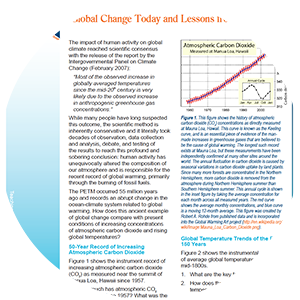Actvity Summary: Review a series of articles on the Paleocene-Eocene Thermal Maximum (PETM) using shipboard data and analysis.
Since 1968, scientific ocean drilling has tapped into a considerable archive of Earth history, and in doing so has revealed much about the processes that drive our planet’s dynamic character. For one, our understanding of the ancient ocean-climate system has greatly advanced because of the findings of deep-sea drilling. These advances have benefited from improved coring technologies, utilization of a wide variety of techniques for non-destructive characterization of cored material, creative scientific drilling proposals, generation of high resolution geochemical records (e.g., stable isotopes), and building upon earlier drilling results.
One of the major take-away messages from this facet of scientific ocean drilling is that the ocean-climate system is not always characterized by the slow, gradual, continuous change predicted by James Hutton, Charles Lyell, and Charles Darwin. Rather, it has been perturbed by rapid changes many times in the past. Some perturbations were caused by rare events, such as the bolide impact that likely triggered the last great mass extinction event at the end of the Cretaceous Period (65.5 Ma), which heralded new opportunities for biotic evolution in the Paleogene and Neogene Periods. In addition, we have come to appreciate the importance of positive and negative feedbacks in the climate system, Milankovitch orbital forcing, opening and closing of oceanic gateways, growth of major mountain belts, and large-scale volcanism as agents of global change. At times, these varied influences have culminated in an abrupt change in the ocean-climate system caused by the crossing of some critical threshold, thereby triggering a rapid disruption to the steady-state climate system.
We do not yet fully understand all the linkages among these variables. The deep-sea sedimentary record has provided stunning examples of just how quickly the Earth’s interconnected systems can be perturbed. The latest Cretaceous and Paleogene Periods contain several prominent examples of abrupt changes in the ocean-climate system, including the Cretaceous/Paleogene (K/P) boundary, the Paleocene/Eocene Thermal Maximum (PETM), and the earliest Oligocene glaciation (Oi1 event) of Antarctica. The Neogene has witnessed the rapid Oligocene/Miocene glaciation (Mi1 event) of Antarctica, the mid-Miocene climatic optimum, the middle Miocene glaciation (Mi3-Mi4 event) of Antarctica, and the onset of Northern Hemisphere glaciation.
- Standard B: Science as inquiry
- Standard E: Earth and space science
- Cause and effect
- Analyzing and interpreting data
- ESS1. C The history of the planet Earth
- ESS2.C The roles of water in Earth’s surface processes
- ESS2. D Weather and climate
- ESS3.D Global climate change
